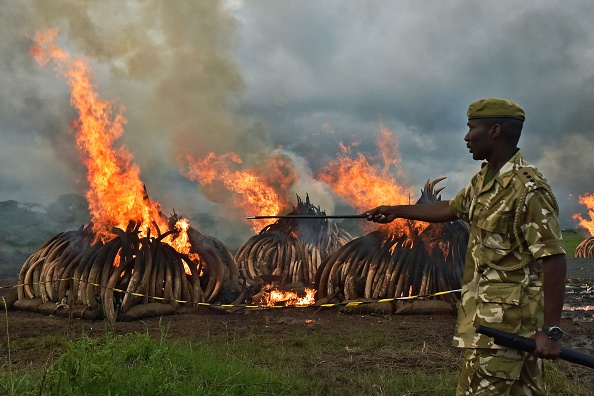
Kenya Wildlife Services (KWS) rangers stand guard around illegal stockpiles of burning elephant tusks, ivory figurines and rhinoceros horns at the Nairobi National Park on April 30, 2016. Kenyan President Uhuru Kenyatta set fire on April 30, 2016, to the world's biggest ivory bonfire, after demanding a total ban on trade in tusks and horns to end "murderous" trafficking and prevent the extinction of elephants in the wild. / AFP / CARL DE SOUZA (Photo credit should read CARL DE SOUZA/AFP/Getty Images)
[blogo-gallery id=”163300″ layout=”photostory”]
Undici enormi falò sono stati accesi quest’oggi nel Parco Nazionale di Nairobi, per quello che è stato il più grande rogo di “oro bianco” della storia.
Su Ecoblog vi abbiamo raccontato spesso di queste distruzioni fortemente simboliche. Ultimamente ne è stata organizzata una anche a Roma, alla presenza del ministro dell’Ambiente Galletti.
Il rogo di oggi a Nairobi, però, è davvero un evento: ben 105 tonnellate di zanne e corni sono accatastate e bruceranno per giorni, mandando in fumo circa il 5% dello stock mondiale di avorio accumulato con l’abbattimento di settemila pachidermi e centinaia di elefanti.
[blogo-video id=”166169″ title=”Rogo in Kenya” content=”” provider=”askanews” image_url=”http://engine.mperience.net/cdn/static/img/tmnews/20160430_video_11392324.jpg” thumb_maxres=”0″ url=”20160430_video_11392324″ embed=”PGRpdiBpZD0nbXAtdmlkZW9fY29udGVudF9fMTY2MTY5JyBjbGFzcz0nbXAtdmlkZW9fY29udGVudCc+PHNjcmlwdCB0eXBlPSJ0ZXh0L2phdmFzY3JpcHQiIHNyYz0iaHR0cDovL2VuZ2luZS5tcGVyaWVuY2UubmV0L0VuZ2luZVdpZGdldC9zY3JpcHRzL3dpZGdldF8xIj48L3NjcmlwdD48ZGl2IGNsYXNzPSJtcGVfd2lkZ2V0IiBkYXRhLW1wZT0ndHlwZT1wbGF5ZXJ8YXBwSWQ9MTl8dGFyZ2V0SWQ9MjAxNjA0MzBfdmlkZW9fMTEzOTIzMjR8cGxheWVyT3B0aW9ucz17ImF1dG9wbGF5Ijoibm9uZSIsImFkdlVSTCI6Imh0dHA6Ly9pYi5hZG54cy5jb20vcHR2P21lbWJlcj0zNzA3JTI2JWludl9jb2RlPXByZXJvbGwtYXNrYW5ld3MteDUwLWRlc2t0b3AiLCJ1c2VJbWFTREsiOnRydWV9Jz48L2Rpdj48c3R5bGU+I21wLXZpZGVvX2NvbnRlbnRfXzE2NjE2OXtwb3NpdGlvbjogcmVsYXRpdmU7cGFkZGluZy1ib3R0b206IDU2LjI1JTtoZWlnaHQ6IDAgIWltcG9ydGFudDtvdmVyZmxvdzogaGlkZGVuO3dpZHRoOiAxMDAlICFpbXBvcnRhbnQ7fSAjbXAtdmlkZW9fY29udGVudF9fMTY2MTY5IC5icmlkLCAjbXAtdmlkZW9fY29udGVudF9fMTY2MTY5IGlmcmFtZSB7cG9zaXRpb246IGFic29sdXRlICFpbXBvcnRhbnQ7dG9wOiAwICFpbXBvcnRhbnQ7IGxlZnQ6IDAgIWltcG9ydGFudDt3aWR0aDogMTAwJSAhaW1wb3J0YW50O2hlaWdodDogMTAwJSAhaW1wb3J0YW50O308L3N0eWxlPjwvZGl2Pg==”]
È stato lo stesso presidente Uhuru Kenyatta a dare il via al rogo di una delle undici piramidi.
By destroying ivory, we declare once and for all that our National Heritage is not for sale. pic.twitter.com/4b1TbhUFhY
— Uhuru Kenyatta (@UKenyatta) 30 aprile 2016
Obiettivo di questa pubblica cremazione e delle distruzioni che avvengono ormai in tutto il mondo è diffondere una nuova sensibilità su questo tema e arrivare a bloccare lo sterminio di questi animali in via d’estinzione. Ogni anno, infatti, i cacciatori di frodo uccidono 30mila elefanti.
Via | Askanews



